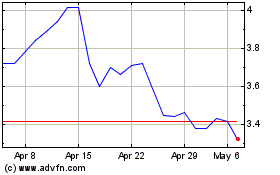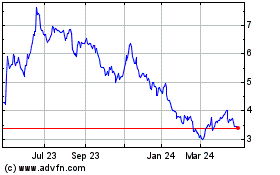Valneva to Present Lyme Disease and
Chikungunya Vaccine Updates at R&D Investor Day in New York
City on July 9th
Live webcast beginning at 8:30am EDT / 2:30pm
CEST
Saint Herblain (France), June 11,
2019 – Valneva SE (“Valneva” or “the Company”), a biotech
company developing and commercializing vaccines for infectious
diseases with major unmet medical needs, today announced that it
will host a Research & Development (R&D) Investor Day on
Tuesday, July 9th, 2019 in New York City, from 8:30a.m. to
11:00a.m. Eastern Daylight Time (EDT).
Members of Valneva’s Management Board, including
Thomas Lingelbach (Chief Executive Officer) and Wolfgang Bender
(Chief Medical Officer), will give a full update on the Company’s
two leading vaccine clinical development programs, VLA15 (Lyme
disease) and VLA1553 (chikungunya).
Valneva’s vaccine candidate VLA15 is the only
Lyme disease vaccine in clinical development worldwide, while the
Company’s unique chikungunya vaccine candidate, VLA1553, has
potential single-shot long-term efficacy.
R&D Investor Day Event
DetailsThe event will be held on Tuesday, July 9th at the
Parker Hotel in New York City. Doors will open at 7.45a.m. for
registration and breakfast, and the event will end around 11:00a.m.
The live event is open to institutional investors, financial
analysts, and business development professionals only or by
invitation from the Company. Registration for the event can be
found at
http://events.constantcontact.com/register/event?llr=mlhnstzab&oeidk=a07egdvisy78c47d7fd.
WebcastA live webcast of the
event will be available starting at 8.30am at
http://lifesci.rampard.com/20190709. It will also be available,
post-event, in the Investor section of the Company’s website at
www.valneva.com.
About Lyme Disease Lyme disease
is a systemic infection caused by Borrelia bacteria transmitted to
humans by infected Ixodes ticks1. It is considered the most common
vector borne illness in the Northern Hemisphere. According to the
US Centers for Disease Control and Prevention (CDC), approximately
300,000 Americans2 are diagnosed with Lyme disease each year with
at least a further 200,000 cases in Europe3. Early symptoms of Lyme
disease (such as a gradually expanding erythematous rash called
Erythema migrans or more unspecific symptoms like fatigue, fever,
headache, mild stiff neck, arthralgia or myalgia) are often
overlooked or misinterpreted. Left untreated, the disease can
disseminate and cause more serious complications affecting the
joints (arthritis), the heart (carditis) or the nervous system. The
medical need for vaccination against Lyme disease is steadily
increasing as the disease footprint widens4.
About VLA15Valneva’s vaccine
candidate, VLA15, is currently the only active vaccine program in
clinical development against Lyme disease. The program was granted
Fast Track designation by the U.S. Food and Drug Administration
(FDA) in July 20175 and Valneva reported positive interim Phase 1
results in March 20186. VLA15 showed a favourable safety profile
and was immunogenic in all doses and formulations tested with good
OspA-specific IgG antibody responses against all OspA
serotypes.VLA15 is a multivalent, protein subunit vaccine that
targets the outer surface protein A (OspA) of Borrelia. It is
designed for prophylactic, active immunization against Lyme disease
aiming for protection against the majority of human pathogenic
Borrelia species. VLA15 is designed to confer protection by raising
antibodies that prevent Borrelia from migrating from ticks to
humans after a bite. The safety profile is expected to be similar
to other vaccines using the same technology that have been approved
for active immunization in adults and children. The target
population includes individuals at risk above 2 years of age living
in endemic areas, people planning to travel to endemic areas to
pursue outdoor activities and people at risk who have a history of
Lyme disease (as infection with Borrelia does not confer protective
immunity against all pathogenic Borrelia species).Vaccination with
OspA was already proven to work in the 1990s and VLA15 pre-clinical
data showed that the vaccine has the potential to provide
protection against the majority of the Borrelia species pathogenic
for humans7.
About Chikungunya Chikungunya
is a mosquito-borne viral disease caused by the chikungunya virus
(CHIKV), a Togaviridae virus, transmitted by Aedes mosquitoes.
Clinical symptoms include acute onset of fever, debilitating joint
and muscle pain, headache, nausea and rash, potentially developing
into long-term, serious health impairments. Chikungunya virus
causes clinical illness in 72-92% of infected humans around 4 to 7
days after an infected mosquito bite. Complications resulting from
the disease include visual, neurological, heart and
gastrointestinal manifestations; fatalities have been reported
(case fatality rates of 0.1% to 4.9% from epidemics)8 in elderly
patients at higher risk. Chikungunya outbreaks have been reported
in Asia, Africa, the Americas and recently (2017) in Europe. As of
2017, there have been more than one million reported cases in the
Americas9 and the economic impact is considered to be
significant (e.g. Colombia outbreak 2014: $73.6m10). The medical
and economic burden is expected to grow as the CHIKV primary
mosquito vectors continue to further spread geographically. There
are no preventive vaccines or effective treatments available and,
as such, chikungunya is considered to be a major public health
threat.
About VLA1553VLA1553 is a
monovalent, single dose, live-attenuated vaccine candidate for
protection against chikungunya and was granted Fast Track
designation by the U.S. Food and Drug Administration (FDA) in
December 201811. The vaccine candidate is designed for
prophylactic, active, single-dose immunization against chikungunya
in humans over one year old. The vaccine targets long-lasting
protection and an anticipated safety profile similar to licensed
vaccines for active immunization in adults and children. The target
population segments are travelers, military personnel and
individuals at risk living in endemic regions. The global market
for vaccines against chikungunya is estimated at up to €500 million
annually12.VLA1553 is based on an infectious clone (CHIKV
LR2006-OPY1) attenuated by deleting a major part of the gene
encoding the non-structural replicase complex protein nsP3, aiming
for protection against various chikungunya virus outbreak
phylogroups and strains13. In pre-clinical development, a
single-vaccine shot was shown to be highly immunogenic in
vaccinated Non-Human Primates (NHP) (cynomolgus macaques) and
showed no signs of viremia after challenge14. In NHPs, VLA1553
induced a strong, long lasting (more than 300 days) neutralizing
antibody response comparable to wild-type CHIKV infections,
combined with a good safety profile.
About Valneva SEValneva is a
biotech company developing and commercializing vaccines for
infectious diseases with major unmet needs. Valneva’s portfolio
includes two commercial vaccines for travelers: IXIARO®/JESPECT®
indicated for the prevention of Japanese encephalitis and DUKORAL®
indicated for the prevention of cholera and, in some countries,
prevention of diarrhea caused by ETEC. The Company has various
vaccines in development including a unique vaccine against Lyme
disease. Valneva has operations in Austria, Sweden, the United
Kingdom, France, Canada and the US with approximately 480
employees. More information is available at www.valneva.com.
| Valneva
Investor and Media ContactsLaetitia
Bachelot-FontaineGlobal Head of Investor Relations & Corporate
CommunicationsM +33 (0)6 4516 7099investors@valneva.com |
Teresa
PinzolitsCorporate Communications SpecialistT +43 (0)1 20620
1116communications@valneva.com |
Forward-Looking StatementsThis
press release contains certain forward-looking statements relating
to the business of Valneva, including with respect to the progress,
timing and completion of research, development and clinical trials
for product candidates, the ability to manufacture, market,
commercialize and achieve market acceptance for product candidates,
the ability to protect intellectual property and operate the
business without infringing on the intellectual property rights of
others, estimates for future performance and estimates regarding
anticipated operating losses, future revenues, capital requirements
and needs for additional financing. In addition, even if the actual
results or development of Valneva are consistent with the
forward-looking statements contained in this press release, those
results or developments of Valneva may not be indicative of their
in the future. In some cases, you can identify forward-looking
statements by words such as "could," "should," "may," "expects,"
"anticipates," "believes," "intends," "estimates," "aims,"
"targets," or similar words. These forward-looking statements are
based largely on the current expectations of Valneva as of the date
of this press release and are subject to a number of known and
unknown risks and uncertainties and other factors that may cause
actual results, performance or achievements to be materially
different from any future results, performance or achievement
expressed or implied by these forward-looking statements. In
particular, the expectations of Valneva could be affected by, among
other things, uncertainties involved in the development and
manufacture of vaccines, unexpected clinical trial results,
unexpected regulatory actions or delays, competition in general,
currency fluctuations, the impact of the global and European credit
crisis, and the ability to obtain or maintain patent or other
proprietary intellectual property protection. In light of these
risks and uncertainties, there can be no assurance that the
forward-looking statements made during this presentation will in
fact be realized. Valneva is providing the information in these
materials as of this press release, and disclaim any intention or
obligation to publicly update or revise any forward-looking
statements, whether as a result of new information, future events,
or otherwise.
1 Stanek et al. 2012, The Lancet 379:461–473
2 As estimated by the CDC,
https://www.cdc.gov/lyme/stats/humancases.html.3 Estimated from
available national data. Number largely underestimated based
on WHO Europe Lyme Report as case reporting is highly
inconsistent in Europe and many LB infections go undiagnosed; ECDC
tick-borne-diseases-meeting-report4 New Scientist, Lyme disease is
set to explode and we still don’t have a vaccine; March 29, 2017
https://www.newscientist.com/article/mg23431195-800-lyme-disease-is-set-to-explode-and-you-cant-protect-yourself/5
http://www.valneva.com/en/investors-media/news/2018;6 Valneva Press
Release March 19, 2018: Valneva Reports Positive Phase I Interim
Results for Its Lyme Vaccine Candidate VLA15.7
http://www.plosone.org/article/info%3Adoi%2F10.1371%2Fjournal.pone.0113294.8
WHO, PAHO9 PAHO/WHO data: Number of reported cases of Chikungunya
Fever in the Americas – EW 51 (December 22, 2017)10 Cardona-Ospina
et al., Trans R Soc Trip Med Hyg 201511 Valneva PR: Valneva Awarded
FDA Fast Track Designation for Chikungunya vaccine candidate12
Company estimate support by an independent market study13
Hallengärd et al. 2013 J. Virology 88: 2858-286614 Roques et al.
2017JCI Insight 2 (6): e83527
- 2019_06_11_VLA_R&D_Day_PR_EN
Valneva (EU:VLA)
Historical Stock Chart
From Mar 2024 to Apr 2024

Valneva (EU:VLA)
Historical Stock Chart
From Apr 2023 to Apr 2024
